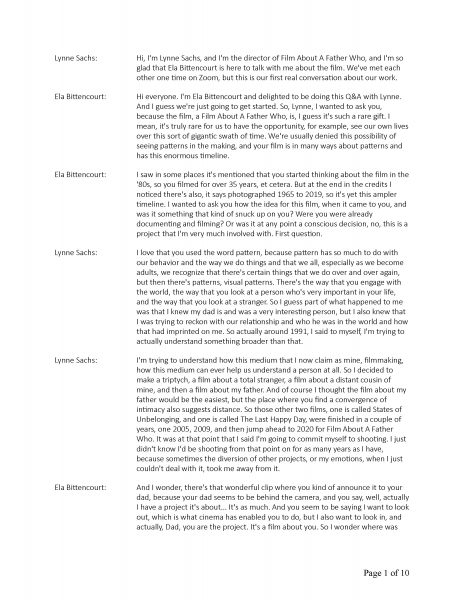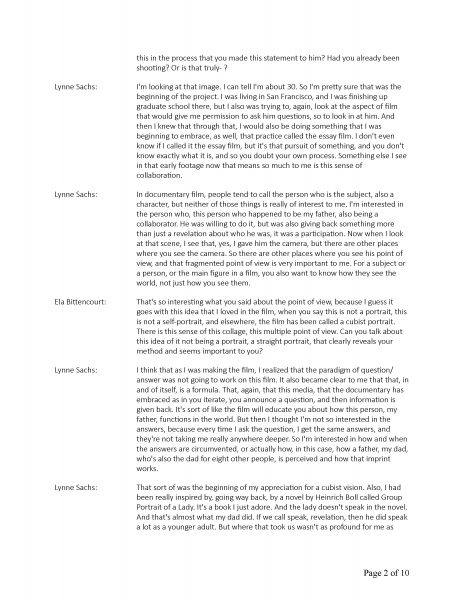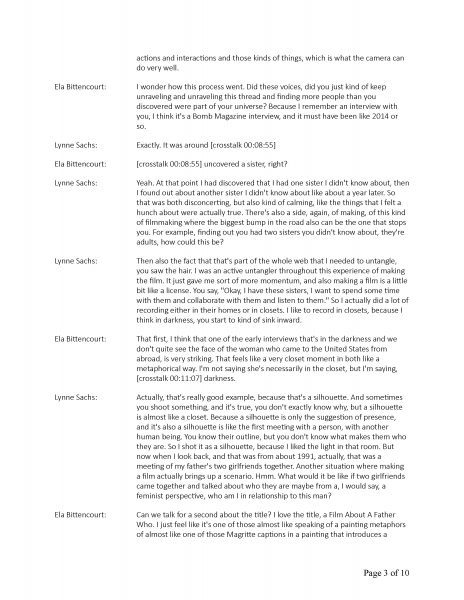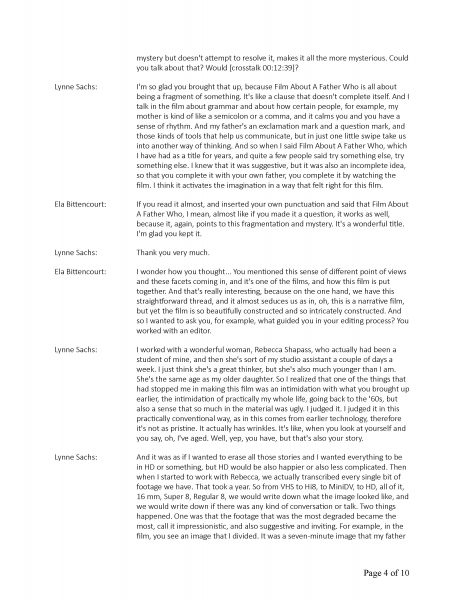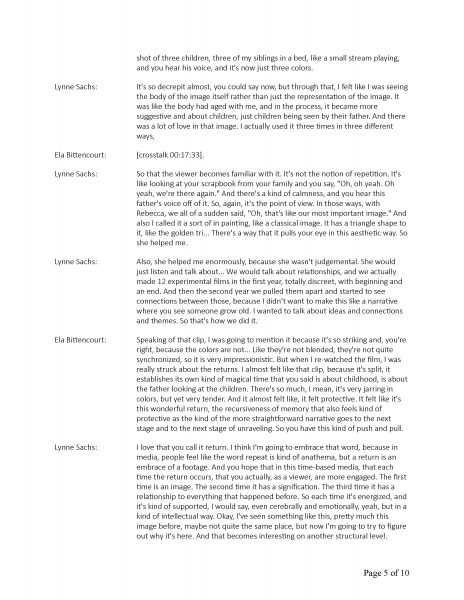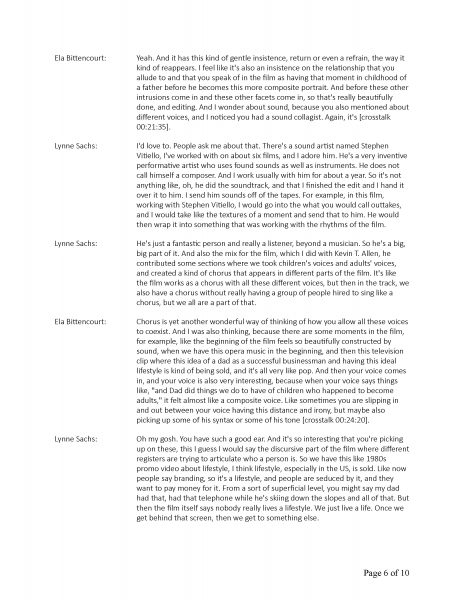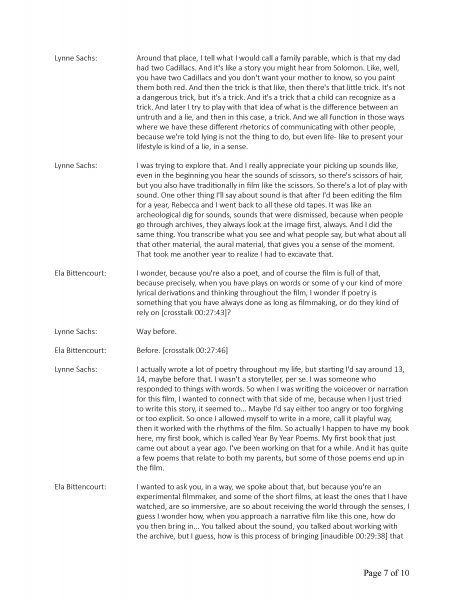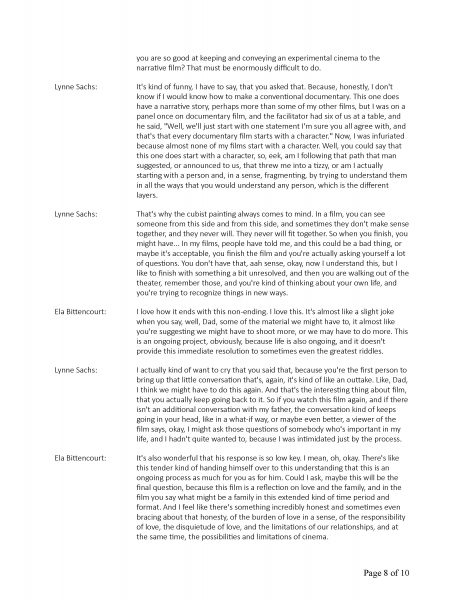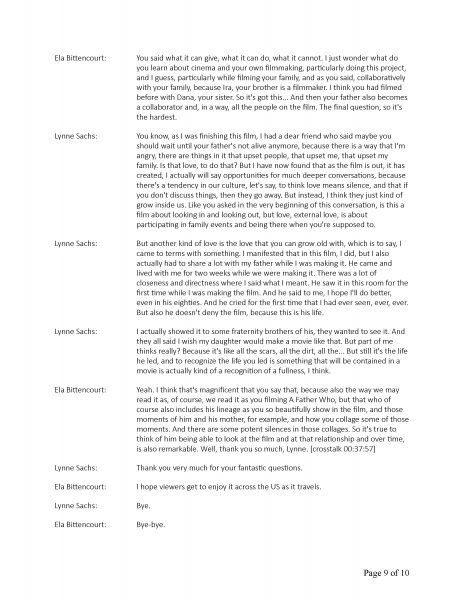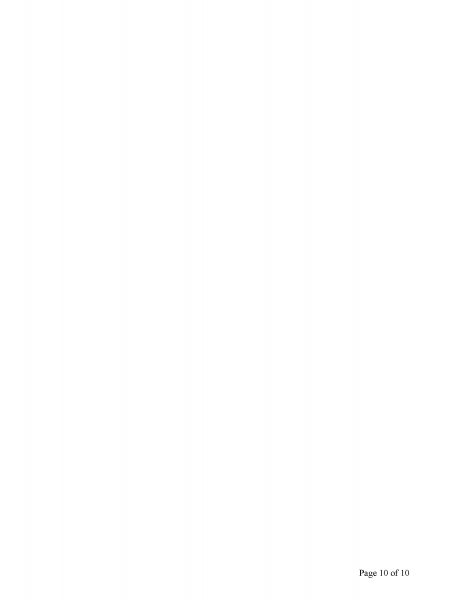A conversation between filmmaker Lynne Sachs and critic & cultural journalist Ela Bittencourt on the occasion of “Film About a Father Who”‘s Cinema Guild release in virtual theaters in 2021.
Interview Transcript
Lynne Sachs: Hi, I’m Lynne Sachs, and I’m the director of Film About A Father Who, and I’m so glad that Ela Bittencourt is here to talk with me about the film. We’ve met each other one time on Zoom, but this is our first real conversation about our work.
Ela Bittencourt: Hi everyone. I’m Ela Bittencourt and delighted to be doing this Q&A with Lynne. And I guess we’re just going to get started. So, Lynne, I wanted to ask you, because the film, a Film About A Father Who, is, I guess it’s such a rare gift. I mean, it’s truly rare for us to have the opportunity, for example, see our own lives over this sort of gigantic swath of time. We’re usually denied this possibility of seeing patterns in the making, and your film is in many ways about patterns and has this enormous timeline.
Ela Bittencourt: I saw in some places it’s mentioned that you started thinking about the film in the ’80s, so you filmed for over 35 years, et cetera. But at the end in the credits I noticed there’s also, it says photographed 1965 to 2019, so it’s yet this ampler timeline. I wanted to ask you how the idea for this film, when it came to you, and was it something that kind of snuck up on you? Were you were already documenting and filming? Or was it at any point a conscious decision, no, this is a project that I’m very much involved with. First question.
Lynne Sachs: I love that you used the word pattern, because pattern has so much to do with our behavior and the way we do things and that we all, especially as we become adults, we recognize that there’s certain things that we do over and over again, but then there’s patterns, visual patterns. There’s the way that you engage with the world, the way that you look at a person who’s very important in your life, and the way that you look at a stranger. So I guess part of what happened to me was that I knew my dad is and was a very interesting person, but I also knew that I was trying to reckon with our relationship and who he was in the world and how that had imprinted on me. So actually around 1991, I said to myself, I’m trying to actually understand something broader than that.
I’m trying to understand how this medium that I now claim as mine, filmmaking, how this medium can ever help us understand a person at all. So I decided to make a triptych, a film about a total stranger, a film about a distant cousin of mine, and then a film about my father. And of course I thought the film about my father would be the easiest, but the place where you find a convergence of intimacy also suggests distance. So those other two films, one is called States of Unbelonging, and one is called The Last Happy Day, were finished in a couple of years, one 2005, 2009, and then jump ahead to 2020 for Film About A Father Who. It was at that point that I said I’m going to commit myself to shooting. I just didn’t know I’d be shooting from that point on for as many years as I have, because sometimes the diversion of other projects, or my emotions, when I just couldn’t deal with it, took me away from it.
Ela Bittencourt: And I wonder, there’s that wonderful clip where you kind of announce it to your dad, because your dad seems to be behind the camera, and you say, well, actually I have a project it’s about… It’s as much. And you seem to be saying I want to look out, which is what cinema has enabled you to do, but I also want to look in, and actually, Dad, you are the project. It’s a film about you. So I wonder where was this in the process that you made this statement to him? Had you already been shooting? Or is that truly- ?
Lynne Sachs: I’m looking at that image. I can tell I’m about 30. So I’m pretty sure that was the beginning of the project. I was living in San Francisco, and I was finishing up graduate school there, but I also was trying to, again, look at the aspect of film that would give me permission to ask him questions, so to look in at him. And then I knew that through that, I would also be doing something that I was beginning to embrace, as well, that practice called the essay film. I don’t even know if I called it the essay film, but it’s that pursuit of something, and you don’t know exactly what it is, and so you doubt your own process. Something else I see in that early footage now that means so much to me is this sense of collaboration.
In documentary film, people tend to call the person who is the subject, also a character, but neither of those things is really of interest to me. I’m interested in the person who, this person who happened to be my father, also being a collaborator. He was willing to do it, but was also giving back something more than just a revelation about who he was, it was a participation. Now when I look at that scene, I see that, yes, I gave him the camera, but there are other places where you see the camera. So there are other places where you see his point of view, and that fragmented point of view is very important to me. For a subject or a person, or the main figure in a film, you also want to know how they see the world, not just how you see them.
Ela Bittencourt: That’s so interesting what you said about the point of view, because I guess it goes with this idea that I loved in the film, when you say this is not a portrait, this is not a self-portrait, and elsewhere, the film has been called a cubist portrait. There is this sense of this collage, this multiple point of view. Can you talk about this idea of it not being a portrait, a straight portrait, that clearly reveals your method and seems important to you?
Lynne Sachs: I think that as I was making the film, I realized that the paradigm of question/answer was not going to work on this film. It also became clear to me that that, in and of itself, is a formula. That, again, that this media, that the documentary has embraced as in you iterate, you announce a question, and then information is given back. It’s sort of like the film will educate you about how this person, my father, functions in the world. But then I thought I’m not so interested in the answers, because every time I ask the question, I get the same answers, and they’re not taking me really anywhere deeper. So I’m interested in how and when the answers are circumvented, or actually how, in this case, how a father, my dad, who’s also the dad for eight other people, is perceived and how that imprint works.
That sort of was the beginning of my appreciation for a cubist vision. Also, I had been really inspired by, going way back, by a novel by Heinrich Boll called Group Portrait of a Lady. It’s a book I just adore. And the lady doesn’t speak in the novel. And that’s almost what my dad did. If we call speak, revelation, then he did speak a lot as a younger adult. But where that took us wasn’t as profound for me as actions and interactions and those kinds of things, which is what the camera can do very well.
Ela Bittencourt: I wonder how this process went. Did these voices, did you just kind of keep unraveling and unraveling this thread and finding more people than you discovered were part of your universe? Because I remember an interview with you, I think it’s a Bomb Magazine interview, and it must have been like 2014 or so.
Lynne Sachs: Exactly. It was around [crosstalk 00:08:55]
Ela Bittencourt: [crosstalk 00:08:55] uncovered a sister, right?
Lynne Sachs: Yeah. At that point I had discovered that I had one sister I didn’t know about, then I found out about another sister I didn’t know about like about a year later. So that was both disconcerting, but also kind of calming, like the things that I felt a hunch about were actually true. There’s also a side, again, of making, of this kind of filmmaking where the biggest bump in the road also can be the one that stops you. For example, finding out you had two sisters you didn’t know about, they’re adults, how could this be?
Then also the fact that that’s part of the whole web that I needed to untangle, you saw the hair. I was an active untangler throughout this experience of making the film. It just gave me sort of more momentum, and also making a film is a little bit like a license. You say, “Okay, I have these sisters, I want to spend some time with them and collaborate with them and listen to them.” So I actually did a lot of recording either in their homes or in closets. I like to record in closets, because I think in darkness, you start to kind of sink inward.
Ela Bittencourt: That first, I think that one of the early interviews that’s in the darkness and we don’t quite see the face of the woman who came to the United States from abroad, is very striking. That feels like a very closet moment in both like a metaphorical way. I’m not saying she’s necessarily in the closet, but I’m saying, [crosstalk 00:11:07] darkness.
Lynne Sachs: Actually, that’s really good example, because that’s a silhouette. And sometimes you shoot something, and it’s true, you don’t exactly know why, but a silhouette is almost like a closet. Because a silhouette is only the suggestion of presence, and it’s also a silhouette is like the first meeting with a person, with another human being. You know their outline, but you don’t know what makes them who they are. So I shot it as a silhouette, because I liked the light in that room. But now when I look back, and that was from about 1991, actually, that was a meeting of my father’s two girlfriends together. Another situation where making a film actually brings up a scenario. Hmm. What would it be like if two girlfriends came together and talked about who they are maybe from a, I would say, a feminist perspective, who am I in relationship to this man?
Ela Bittencourt: Can we talk for a second about the title? I love the title, a Film About A Father Who. I just feel like it’s one of those almost like speaking of a painting metaphors of almost like one of those Magritte captions in a painting that introduces a mystery but doesn’t attempt to resolve it, makes it all the more mysterious. Could you talk about that? Would [crosstalk 00:12:39]?
Lynne Sachs: I’m so glad you brought that up, because Film About A Father Who is all about being a fragment of something. It’s like a clause that doesn’t complete itself. And I talk in the film about grammar and about how certain people, for example, my mother is kind of like a semicolon or a comma, and it calms you and you have a sense of rhythm. And my father’s an exclamation mark and a question mark, and those kinds of tools that help us communicate, but in just one little swipe take us into another way of thinking. And so when I said Film About A Father Who, which I have had as a title for years, and quite a few people said try something else, try something else. I knew that it was suggestive, but it was also an incomplete idea, so that you complete it with your own father, you complete it by watching the film. I think it activates the imagination in a way that felt right for this film.
Ela Bittencourt: If you read it almost, and inserted your own punctuation and said that Film About A Father Who, I mean, almost like if you made it a question, it works as well, because it, again, points to this fragmentation and mystery. It’s a wonderful title. I’m glad you kept it.
Lynne Sachs: Thank you very much.
Ela Bittencourt: I wonder how you thought… You mentioned this sense of different point of views and these facets coming in, and it’s one of the films, and how this film is put together. And that’s really interesting, because on the one hand, we have this straightforward thread, and it almost seduces us as in, oh, this is a narrative film, but yet the film is so beautifully constructed and so intricately constructed. And so I wanted to ask you, for example, what guided you in your editing process? You worked with an editor.
Lynne Sachs: I worked with a wonderful woman, Rebecca Shapass, who actually had been a student of mine, and then she’s sort of my studio assistant a couple of days a week. I just think she’s a great thinker, but she’s also much younger than I am. She’s the same age as my older daughter. So I realized that one of the things that had stopped me in making this film was an intimidation with what you brought up earlier, the intimidation of practically my whole life, going back to the ’60s, but also a sense that so much in the material was ugly. I judged it. I judged it in this practically conventional way, as in this comes from earlier technology, therefore it’s not as pristine. It actually has wrinkles. It’s like, when you look at yourself and you say, oh, I’ve aged. Well, yep, you have, but that’s also your story.
Lynne Sachs: And it was as if I wanted to erase all those stories and I wanted everything to be in HD or something, but HD would be also happier or also less complicated. Then when I started to work with Rebecca, we actually transcribed every single bit of footage we have. That took a year. So from VHS to Hi8, to MiniDV, to HD, all of it, 16 mm, Super 8, Regular 8, we would write down what the image looked like, and we would write down if there was any kind of conversation or talk. Two things happened. One was that the footage that was the most degraded became the most, call it impressionistic, and also suggestive and inviting. For example, in the film, you see an image that I divided. It was a seven-minute image that my father shot of three children, three of my siblings in a bed, like a small stream playing, and you hear his voice, and it’s now just three colors.
Lynne Sachs: It’s so decrepit almost, you could say now, but through that, I felt like I was seeing the body of the image itself rather than just the representation of the image. It was like the body had aged with me, and in the process, it became more suggestive and about children, just children being seen by their father. And there was a lot of love in that image. I actually used it three times in three different ways,
Ela Bittencourt: [crosstalk 00:17:33].
Lynne Sachs: So that the viewer becomes familiar with it. It’s not the notion of repetition. It’s like looking at your scrapbook from your family and you say, “Oh, oh yeah. Oh yeah, we’re there again.” And there’s a kind of calmness, and you hear this father’s voice off of it. So, again, it’s the point of view. In those ways, with Rebecca, we all of a sudden said, “Oh, that’s like our most important image.” And also I called it a sort of in painting, like a classical image. It has a triangle shape to it, like the golden tri… There’s a way that it pulls your eye in this aesthetic way. So she helped me.
Lynne Sachs: Also, she helped me enormously, because she wasn’t judgemental. She would just listen and talk about… We would talk about relationships, and we actually made 12 experimental films in the first year, totally discreet, with beginning and an end. And then the second year we pulled them apart and started to see connections between those, because I didn’t want to make this like a narrative where you see someone grow old. I wanted to talk about ideas and connections and themes. So that’s how we did it.
Ela Bittencourt: Speaking of that clip, I was going to mention it because it’s so striking and, you’re right, because the colors are not… Like they’re not blended, they’re not quite synchronized, so it is very impressionistic. But when I re-watched the film, I was really struck about the returns. I almost felt like that clip, because it’s split, it establishes its own kind of magical time that you said is about childhood, is about the father looking at the children. There’s so much, I mean, it’s very jarring in colors, but yet very tender. And it almost felt like, it felt protective. It felt like it’s this wonderful return, the recursiveness of memory that also feels kind of protective as the kind of the more straightforward narrative goes to the next stage and to the next stage of unraveling. So you have this kind of push and pull.
Lynne Sachs: I love that you call it return. I think I’m going to embrace that word, because in media, people feel like the word repeat is kind of anathema, but a return is an embrace of a footage. And you hope that in this time-based media, that each time the return occurs, that you actually, as a viewer, are more engaged. The first time is an image. The second time it has a signification. The third time it has a relationship to everything that happened before. So each time it’s energized, and it’s kind of supported, I would say, even cerebrally and emotionally, yeah, but in a kind of intellectual way. Okay, I’ve seen something like this, pretty much this image before, maybe not quite the same place, but now I’m going to try to figure out why it’s here. And that becomes interesting on another structural level.
Ela Bittencourt: Yeah. And it has this kind of gentle insistence, return or even a refrain, the way it kind of reappears. I feel like it’s also an insistence on the relationship that you allude to and that you speak of in the film as having that moment in childhood of a father before he becomes this more composite portrait. And before these other intrusions come in and these other facets come in, so that’s really beautifully done, and editing. And I wonder about sound, because you also mentioned about different voices, and I noticed you had a sound collagist. Again, it’s [crosstalk 00:21:35].
Lynne Sachs: I’d love to. People ask me about that. There’s a sound artist named Stephen Vitiello, I’ve worked with on about six films, and I adore him. He’s a very inventive performative artist who uses found sounds as well as instruments. He does not call himself a composer. And I work usually with him for about a year. So it’s not anything like, oh, he did the soundtrack, and that I finished the edit and I hand it over it to him. I send him sounds off of the tapes. For example, in this film, working with Stephen Vitiello, I would go into the what you would call outtakes, and I would take like the textures of a moment and send that to him. He would then wrap it into something that was working with the rhythms of the film.
He’s just a fantastic person and really a listener, beyond a musician. So he’s a big, big part of it. And also the mix for the film, which I did with Kevin T. Allen, he contributed some sections where we took children’s voices and adults’ voices, and created a kind of chorus that appears in different parts of the film. It’s like the film works as a chorus with all these different voices, but then in the track, we also have a chorus without really having a group of people hired to sing like a chorus, but we all are a part of that.
Ela Bittencourt: Chorus is yet another wonderful way of thinking of how you allow all these voices to coexist. And I was also thinking, because there are some moments in the film, for example, like the beginning of the film feels so beautifully constructed by sound, when we have this opera music in the beginning, and then this television clip where this idea of a dad as a successful businessman and having this ideal lifestyle is kind of being sold, and it’s all very like pop. And then your voice comes in, and your voice is also very interesting, because when your voice says things like, “and Dad did things we do to have of children who happened to become adults,” it felt almost like a composite voice. Like sometimes you are slipping in and out between your voice having this distance and irony, but maybe also picking up some of his syntax or some of his tone [crosstalk 00:24:20].
Lynne Sachs: Oh my gosh. You have such a good ear. And it’s so interesting that you’re picking up on these, this I guess I would say the discursive part of the film where different registers are trying to articulate who a person is. So we have this like 1980s promo video about lifestyle, I think lifestyle, especially in the US, is sold. Like now people say branding, so it’s a lifestyle, and people are seduced by it, and they want to pay money for it. From a sort of superficial level, you might say my dad had that, had that telephone while he’s skiing down the slopes and all of that. But then the film itself says nobody really lives a lifestyle. We just live a life. Once we get behind that screen, then we get to something else.
Around that place, I tell what I would call a family parable, which is that my dad had two Cadillacs. And it’s like a story you might hear from Solomon. Like, well, you have two Cadillacs and you don’t want your mother to know, so you paint them both red. And then the trick is that like, then there’s that little trick. It’s not a dangerous trick, but it’s a trick. And it’s a trick that a child can recognize as a trick. And later I try to play with that idea of what is the difference between an untruth and a lie, and then in this case, a trick. And we all function in those ways where we have these different rhetorics of communicating with other people, because we’re told lying is not the thing to do, but even life- like to present your lifestyle is kind of a lie, in a sense.
I was trying to explore that. And I really appreciate your picking up sounds like, even in the beginning you hear the sounds of scissors, so there’s scissors of hair, but you also have traditionally in film like the scissors. So there’s a lot of play with sound. One other thing I’ll say about sound is that after I’d been editing the film for a year, Rebecca and I went back to all these old tapes. It was like an archeological dig for sounds, sounds that were dismissed, because when people go through archives, they always look at the image first, always. And I did the same thing. You transcribe what you see and what people say, but what about all that other material, the aural material, that gives you a sense of the moment. That took me another year to realize I had to excavate that.
Ela Bittencourt: I wonder, because you’re also a poet, and of course the film is full of that, because precisely, when you have plays on words or some of y our kind of more lyrical derivations and thinking throughout the film, I wonder if poetry is something that you have always done as long as filmmaking, or do they kind of rely on [crosstalk 00:27:43]?
Lynne Sachs: Way before.
Ela Bittencourt: Before. [crosstalk 00:27:46]
Lynne Sachs: I actually wrote a lot of poetry throughout my life, but starting I’d say around 13, 14, maybe before that. I wasn’t a storyteller, per se. I was someone who responded to things with words. So when I was writing the voiceover or narration for this film, I wanted to connect with that side of me, because when I just tried to write this story, it seemed to… Maybe I’d say either too angry or too forgiving or too explicit. So once I allowed myself to write in a more, call it playful way, then it worked with the rhythms of the film. So actually I happen to have my book here, my first book, which is called Year By Year Poems. My first book that just came out about a year ago. I’ve been working on that for a while. And it has quite a few poems that relate to both my parents, but some of those poems end up in the film.
Ela Bittencourt: I wanted to ask you, in a way, we spoke about that, but because you’re an experimental filmmaker, and some of the short films, at least the ones that I have watched, are so immersive, are so about receiving the world through the senses, I guess I wonder how, when you approach a narrative film like this one, how do you then bring in… You talked about the sound, you talked about working with the archive, but I guess, how is this process of bringing [inaudible 00:29:38] that you are so good at keeping and conveying an experimental cinema to the narrative film? That must be enormously difficult to do.
Lynne Sachs: It’s kind of funny, I have to say, that you asked that. Because, honestly, I don’t know if I would know how to make a conventional documentary. This one does have a narrative story, perhaps more than some of my other films, but I was on a panel once on documentary film, and the facilitator had six of us at a table, and he said, “Well, we’ll just start with one statement I’m sure you all agree with, and that’s that every documentary film starts with a character.” Now, I was infuriated because almost none of my films start with a character. Well, you could say that this one does start with a character, so, eek, am I following that path that man suggested, or announced to us, that threw me into a tizzy, or am I actually starting with a person and, in a sense, fragmenting, by trying to understand them in all the ways that you would understand any person, which is the different layers.
Lynne Sachs: That’s why the cubist painting always comes to mind. In a film, you can see someone from this side and from this side, and sometimes they don’t make sense together, and they never will. They never will fit together. So when you finish, you might have… In my films, people have told me, and this could be a bad thing, or maybe it’s acceptable, you finish the film and you’re actually asking yourself a lot of questions. You don’t have that, aah sense, okay, now I understand this, but I like to finish with something a bit unresolved, and then you are walking out of the theater, remember those, and you’re kind of thinking about your own life, and you’re trying to recognize things in new ways.
Ela Bittencourt: I love how it ends with this non-ending. I love this. It’s almost like a slight joke when you say, well, Dad, some of the material we might have to, it almost like you’re suggesting we might have to shoot more, or we may have to do more. This is an ongoing project, obviously, because life is also ongoing, and it doesn’t provide this immediate resolution to sometimes even the greatest riddles.
Lynne Sachs: I actually kind of want to cry that you said that, because you’re the first person to bring up that little conversation that’s, again, it’s kind of like an outtake. Like, Dad, I think we might have to do this again. And that’s the interesting thing about film, that you actually keep going back to it. So if you watch this film again, and if there isn’t an additional conversation with my father, the conversation kind of keeps going in your head, like in a what-if way, or maybe even better, a viewer of the film says, okay, I might ask those questions of somebody who’s important in my life, and I hadn’t quite wanted to, because I was intimidated just by the process.
Ela Bittencourt: It’s also wonderful that his response is so low key. I mean, oh, okay. There’s like this tender kind of handing himself over to this understanding that this is an ongoing process as much for you as for him. Could I ask, maybe this will be the final question, because this film is a reflection on love and the family, and in the film you say what might be a family in this extended kind of time period and format. And I feel like there’s something incredibly honest and sometimes even bracing about that honesty, of the burden of love in a sense, of the responsibility of love, the disquietude of love, and the limitations of our relationships, and at the same time, the possibilities and limitations of cinema.
Ela Bittencourt: You said what it can give, what it can do, what it cannot. I just wonder what do you learn about cinema and your own filmmaking, particularly doing this project, and I guess, particularly while filming your family, and as you said, collaboratively with your family, because Ira, your brother is a filmmaker. I think you had filmed before with Dana, your sister. So it’s got this… And then your father also becomes a collaborator and, in a way, all the people on the film. The final question, so it’s the hardest.
Lynne Sachs: You know, as I was finishing this film, I had a dear friend who said maybe you should wait until your father’s not alive anymore, because there is a way that I’m angry, there are things in it that upset people, that upset me, that upset my family. Is that love, to do that? But I have now found that as the film is out, it has created, I actually will say opportunities for much deeper conversations, because there’s a tendency in our culture, let’s say, to think love means silence, and that if you don’t discuss things, then they go away. But instead, I think they just kind of grow inside us. Like you asked in the very beginning of this conversation, is this a film about looking in and looking out, but love, external love, is about participating in family events and being there when you’re supposed to.
But another kind of love is the love that you can grow old with, which is to say, I came to terms with something. I manifested that in this film, I did, but I also actually had to share a lot with my father while I was making it. He came and lived with me for two weeks while we were making it. There was a lot of closeness and directness where I said what I meant. He saw it in this room for the first time while I was making the film. And he said to me, I hope I’ll do better, even in his eighties. And he cried for the first time that I had ever seen, ever, ever. But also he doesn’t deny the film, because this is his life.
I actually showed it to some fraternity brothers of his, they wanted to see it. And they all said I wish my daughter would make a movie like that. But part of me thinks really? Because it’s like all the scars, all the dirt, all the… But still it’s the life he led, and to recognize the life you led is something that will be contained in a movie is actually kind of a recognition of a fullness, I think.
Ela Bittencourt: Yeah. I think that’s magnificent that you say that, because also the way we may read it as, of course, we read it as you filming A Father Who, but that who of course also includes his lineage as you so beautifully show in the film, and those moments of him and his mother, for example, and how you collage some of those moments. And there are some potent silences in those collages. So it’s true to think of him being able to look at the film and at that relationship and over time, is also remarkable. Well, thank you so much, Lynne. [crosstalk 00:37:57]
Lynne Sachs: Thank you very much for your fantastic questions.
Ela Bittencourt: I hope viewers get to enjoy it across the US as it travels.
Lynne Sachs: Bye.
Ela Bittencourt: Bye-bye.
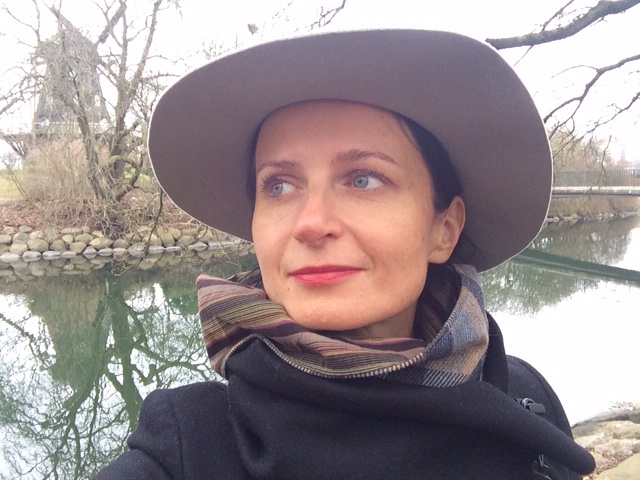
About Ela Bittencourt
Ela Bittencourt is a critic and cultural journalist, currently based in São Paulo. She writes on art, film and literature, often in the context of social issues and politics.

